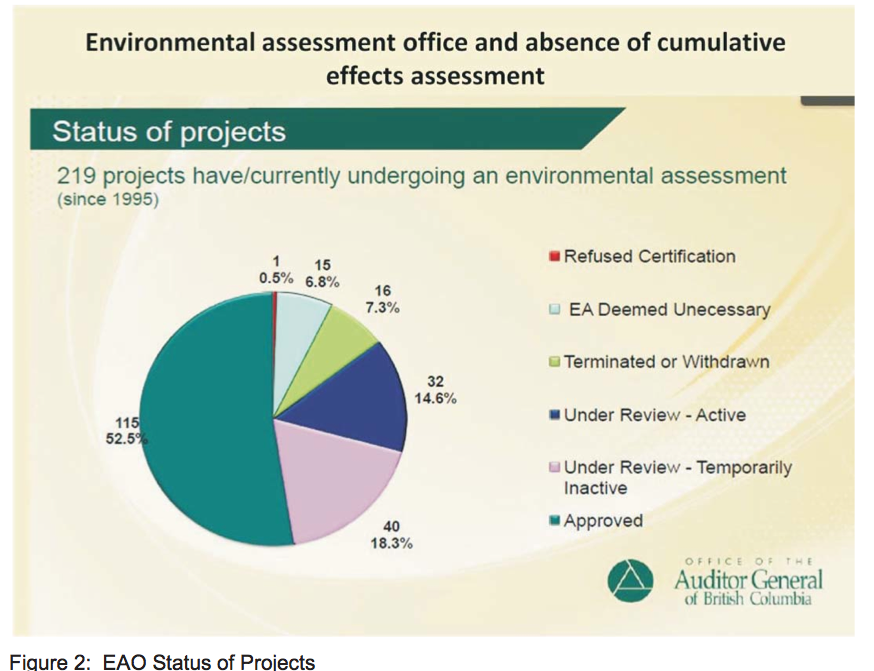
News/Reports
Planning to Fail or Failing to Plan: A Case for New Protected Areas Vision for BC
By Mike Fenger and Jenny Feick, Ph.D.
From The LOG, the Friends of Ecological Reserves Newsletter, Autumn-Winter 2013
To LOG readers: Below is one of the presentations that Friends of Ecological Reserves made while participating in the 4th BC Protected Areas Research Forum held December 3 – 5, 2013 in Kamloops, BC. (See Forum agenda and presentations posted at http://www.unbc.ca/bc-protected-area-research-forum ). FER has had a presence in three out of four of these forums and found this last one stands out as it aligned best with FER’s conservation goals. Our presentation given at the Forum critiques conservation initiatives and the messaging to British Columbians of the adequacy and success of conservation measures within existing parks and the areas between parks. A new approach is desperately needed. We provide both evidence of current shortcomings and elements integral to a new conservation vision.
Abstract
Given climate change, the accelerating pace of natural resource development in British Columbia (B.C.), and economic factors, the Friends of Ecological Reserves (FER) see an urgent need for a robust, new protected areas conservation strategy, which would include the creation of new Ecological Reserves (ERs). This strategy should explicitly consider the rapidly changing natural and cultural landscape and shifting climate context. This vision includes strategic regional land use and natural resource planning with full involvement of First Nations (FN) as well as stakeholders, in the private, public and civil society sectors. This would provide a means to collaboratively craft measures at a local level for sustainable use of natural resources that is mindful of our shared future. A sub-regional strategic planning process would determine the sustainable long term integration needed to optimize conservation opportunities while adding economic developments.
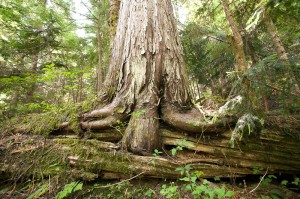
The 100 acres of amazing ancient forest dominated by large Yellow Cedar ( pictured here) and huge Pacific western yew trees on the Sechelt Penninsula would make an ideal new ER. No new ERs have been added to the protected areas systemof B.C. since 2009 as the BC Government and lost its appetite for land use planning and designation of protected areas. ( Phot Courtesy of The Ancient Forest Alliance)
B.C. has the largest and most intact ecosystems remaining in North America in the least developed landscapes south of the 60th parallel. The strategic land use plans of the 1990s established the current protected areas but are dated in light of changes. The effectiveness of conservation measures among protected areas such as Old Growth Management Areas, Wildlife Habitat Areas and various riparian reserve protection measures are unknown. Land use plans did not consider climate change effects or the pace and scale of cumulative effects.
There is sufficient evidence that the status quo for resource management is not working in B.C., though that is not widely understood by the public. Accelerated natural resource development in a period of global climate change warrants an equally accelerated and efficient process to address strategic conservation values before options to make foresighted decisions disappear. Strategic conservation planning seeks to increase the probability of sustaining the diversity of Canada’s most ecologically diverse and biologically rich province.
Introduction
Ninety-four percent of land in British Columbia (B.C.) is publically held, so every British Columbian has a significant stake in this shared asset and thus should understand the state of these commonly held lands. The Friends of Ecological Reserves (FER) is concerned that the message from the provincial government to the taxpayers (i.e. shareholders or owners) is not as informed and thus not as accurate as it needs to be. The government’s message is that protected areas are: well managed, making good returns, and sustaining the ecological integrity for which they were established.
FER asserts, that many important options are needlessly being excluded through lack of strategic direction, long term planning and public input. To support this view, we present information from independent organizations such as the Office of the Auditor General and the Forest Practices Board, which question the status quo management. We believe that if the public at large better understood the current state of protected areas, the condition of natural ecosystems and their importance, then the taxpaying public would not support the status quo, and would seek a better management paradigm for their asset.
This critical look at the status quo is not a criticism of the staff of BC Parks or other natural resource agencies. Instead, it is a call for a shift towards the management of natural resources and protected areas with the following elements:
1. Collaboration and formal involvement with local decision makers through structures such as natural resource boards with community and FN presence and authority that develop plans that integrate conservation needs with development opportunity and assess cumulative effects. This means increased local collaboration over land use planning and transparent reporting on the state of natural resource management at a sub-regional level;
2. Transparent periodic disclosure of the current state of and trends for natural resource management in B.C. at a sub-regional level through a body independent of government, such as a natural resources board/commission with FN sanction, involvement and confidence;
3. Significant improvements in expertise and investment in natural resource management; and
4. Better use of science-based information to inform conservation and the degree to which the current Parks and Protected Areas (PPAs) system needs to be enhanced and connected. A doubling of the current 15% protected areas may be needed to sustain the integrity of ecosystems, diversity, and productivity.
Conservation Connections: The Theme of this Forum
FER is a small Environmental Non-Government Organization (ENGO) principally focused on helping BC Parks staff and ER wardens optimize their time and effort in management of existing Ecological Reserves. B.C.’s 148 ERs are small gems within the existing Parks and Protected Areas system.
The organizing committee of the BC Protected Areas Research Forum selected the theme “Conservation Connections” this year. FER interpreted this theme in two ways: 1) connecting areas, given the biological and spatial context of distances and condition of ecosystems among existing Parks and Protected Areas in B.C.; and 2) connecting people, given the need to connect individuals, organizations and the public to the importance of creating a connected network. This is a practical and reasonable approach to sustaining biodiversity and maintaining the function, diversity, productivity and integrity of ecosystems that serve all British Columbians.
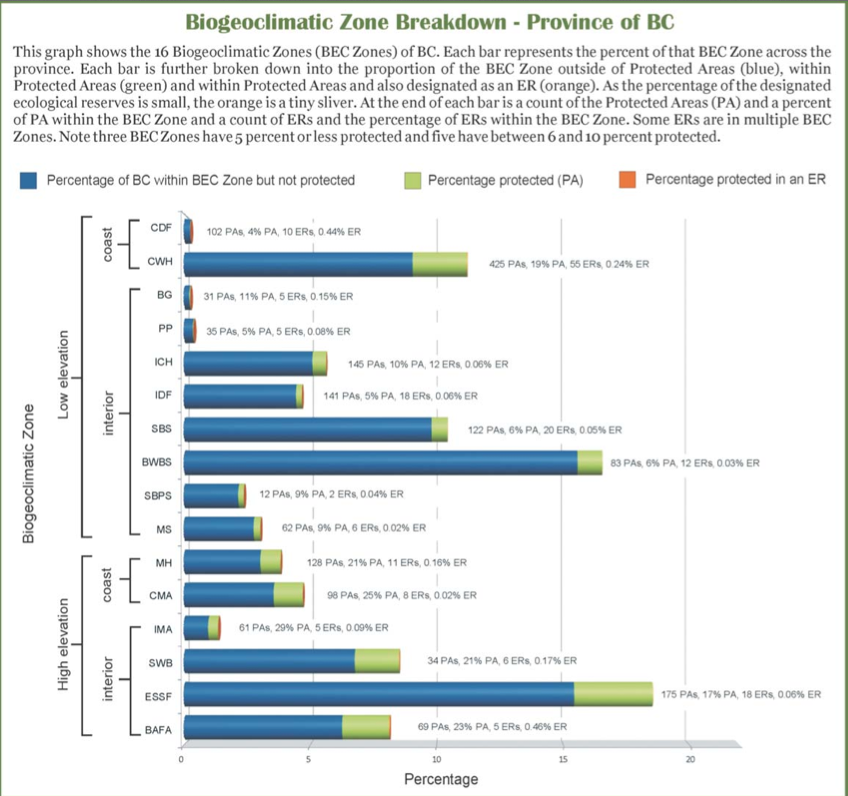
Figure 1: Representation by BEC Zone: Percentage across B.C. in Parks and Protected Areas, and in Ecological Reserves.
A well-connected system of natural areas is probably the only means to sustain the existing biological resources of B.C. in light of accelerated development pressures, current and future effects on ecosystems from climate change, and the decade’s long trend for fewer funds for government staff and natural resource ministry budgets. B.C. is endowed with magnificent natural resource assets. To sustain these publically held shared assets will require significant planning and investment, and a shift to increased sub-regional control.
FER has primarily focused on maintaining the existing ERs. The condition of adjacent land determines the wellbeing (ecological integrity) of ERs. The shareholders of B.C.’s ecosystems should rejoice in the ERs that have been established in the last 40 years. They should also understand that the number of Ecological Reserves has not grown since and the extent of ecosystem representation in the current ER system is far from complete and their protection is inadequate.
FER has a number of strategic goals aligned with the theme of this conference, including:
- To support the development of a resilient and enduring science-based Ecological Reserves system.
- To raise public awareness of the value of ERs and stress their importance as a tool for conservation.
FER hopes that this forum is the catalyst for a wider discussion of the adequacy and connectedness of the existing PPAs system and an acknowledgement of the need to strategically assess protection and where needed, increase the number and extent of the PPAs in B.C. so that they are truly a network. Conservation science supports the need to increase connections among protected areas as part of a larger PPAs network.
We optimistically interpret the connectedness theme of the conference as the beginning of a movement to increase protection from 15% of the province now designated under BC Parks management, to a new PPAs system goal of greater than 30% of land protected. We advise that a new strategic Protected Areas Plan be developed collaboratively, with a public engagement process that leads to new protected areas with landscape level and watershed linkages. This should include increasing ERs from their current number (148) and percentage (0.8%) of the PPAs system in the province.
Auditor General Insights: Evidence That the Status Quo is Not Working
The Office of the Auditor General (AG) chooses government agencies and programs to audit for effectiveness and value to the public. The current breakdown of land ownership and management in B.C. is six percent private, 15% PPAs and 79% Crown land outside of Parks. The BC Parks program was selected for such an audit in 2010. FER was interviewed by the audit team as were BC Parks staff and other organizations concerned with parks management. FER provided our 2005 report entitled “The State of British Columbia’s Ecological Reserves” to the team and was heartened that the AG confirmed concerns identified in this earlier work.
The AG’s recommendations indicated that the AG lacked confidence in the government’s performance of a key goal of BC Parks. The AG stated that “despite its declared intentions and clear vision to conserve the ecological integrity in British Columbia’s parks and protected areas, the Ministry of Environment is not successfully meeting this goal.”
It is one thing for a small ENGO to raise concerns about government agencies. It is quite another for a skilled team of auditors to reach such a conclusion and then make specific recommendations. The AG recommended that the BC Government develop a plan to address current gaps in the PPAs system. FER was very pleased with these recommendations as we believe that the PPAs system which includes ERs, is incomplete.
BC Parks’ response to the AG’s recommendation indicated that BC Parks would purchase private conservation lands if they had the budget to do so. However, the BC Parks response also indicated that there are no plans for new parks or systematic assessment on the need for additions to the current PPAs system, because the strategic land use plans and new park designations have been completed.
The AG also questioned whether BC Parks had a plan to test the ecological integrity of the current system and whether new additions would be needed for the integrity of the system. In our opinion, this question was not addressed and remains unanswered.
When undertaking the expansion of the PPAs system in the 1990s, the direction to the planning tables was to get ecosystem representation increased, with a goal of protecting 12% of the land. Figure 1 shows data on representation levels of Biogeoclimatic Zones today. When the PPAs initiative began, six percent of the British Columbia had protected status.
There are 16 broad climate vegetation zones identified in B.C. under the Biogeoclimatic Ecosystem Classification (BEC) System. The bars in the graph in Figure 1 show the area in each zone in the province. Some zones are very large in area, while others are small. Using BEC zones as broad ecosystem surrogates, there are three zones that have five percent or less representation in Protected Areas, Coastal Douglas Fir, Interior Douglas Fir and Ponderosa Pine zones (CDF, IDF, PP) and three Zones, Sub boreal Spruce, Sub boreal Pine Spruce and Montane Spruce (SBS, SBPS, and MS) represented in PAs at between five and ten percent. The goal for the expansion of the PPAs system in the 1990s was to achieve 12% representation of B.C.’s diversity. Thus, six out of 16 zones are under-represented and arguably these ecosystems are gaps in conservation in B.C.’s PPAs system. The AG specifically asked if there was a systems plan, whether there were gaps in representation, and if there was a plan to ensure the ecological integrity of the Parks system.
FER supports increasing protection in protected areas-deficient zones as a priority for inclusion of new PPAs, including new ERs. We believe the current number and size of PPAs in these zones will be insufficient to sustain biological elements within the system. Many existing protected areas are too small and fragmented. They require strategic planning identifying additions, buffers and/or linkages to improve their integrity. We believe that this is the kind of thoughtful strategic plan the AG had in mind when making a recommendation on gaps and integrity.
FER also hopes BC Parks, Ministry of Environment and the BC Government see the value in strategic planning on the matrix lands between PPAs as an integral part of their mandate. Science-based assessment of fragmentation and vulnerabilities, along with support from other agencies are vital to sustain conservation elements, especially some of the enduring features outside of the current PPAs that could support biological elements through a period of rapid climate change and rapid development.
Some of the conclusions that the AG’s report listed included:
- Significant gaps in the provincial government’s understanding of biodiversity;
- No strategy to address these gaps;
- Inconsistencies and barriers within the legislative framework that inhibit the conservation of biodiversity; and
- Lack of implementation of government’s habitat protection tools and monitoring of their effectiveness are impeding government’s ability to conserve biodiversity.
The conclusions of the AG’s audit across the natural resource ministries are of concern to FER and should be worrisome for the public as well. The findings of the AG lent support for the title of this presentation “Failing to Plan.” Planning requires strategic vision, inventory and monitoring, reporting, transparency, capacity to change course when failing to achieve strategic goals, and investment in natural resource management.
Management is fragmented among the BC Ministry of Environment, which includes BC Parks, the BC Ministry of Forests, Lands and Natural Resource Operations (MFLNRO), and the Oil and Gas Commission. The AG could not find a coherent, effective approach in natural resource management in B.C.
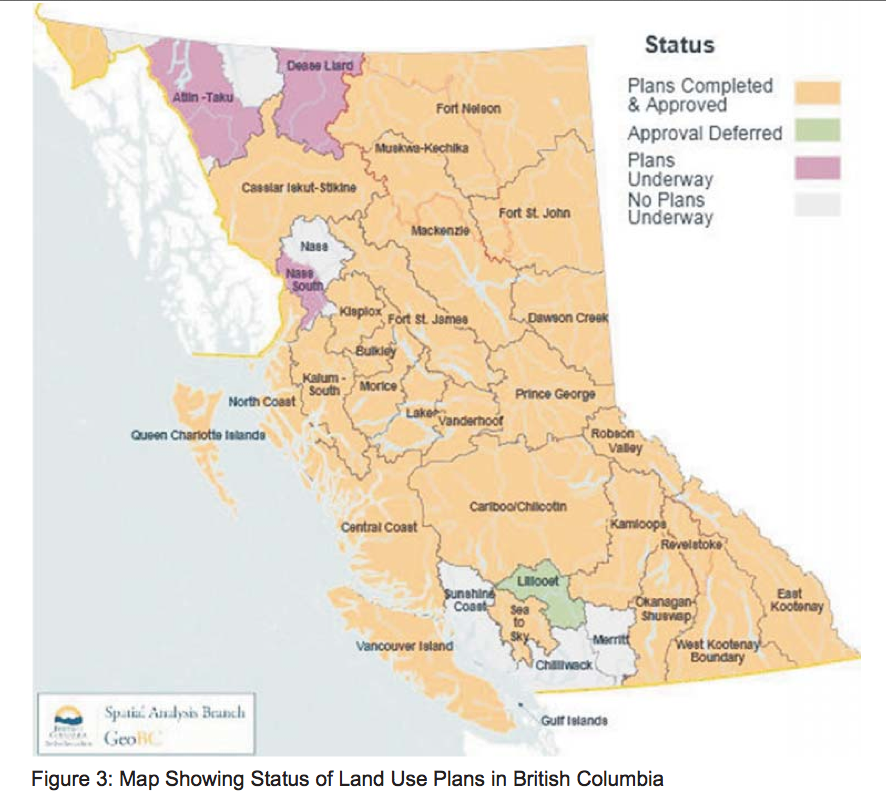 In an audit of MFLNRO, the AG concluded there is no strategic management goal for timber and on how to manage timber supply. The new forest legislation Forest Range Practices Act (FRPA), states that all other natural resource values are secondary to the timber value. In the absence of a provincial plan for timber, there is no means to determine investment and business plans, nor impacts on all other forest values. The BC Government, in their response to the audit, took issue with the AG’s finding, and so there has been no commitment to a provincial vision for timber resources or any of the other forest resource values affected by timber harvesting.
In an audit of MFLNRO, the AG concluded there is no strategic management goal for timber and on how to manage timber supply. The new forest legislation Forest Range Practices Act (FRPA), states that all other natural resource values are secondary to the timber value. In the absence of a provincial plan for timber, there is no means to determine investment and business plans, nor impacts on all other forest values. The BC Government, in their response to the audit, took issue with the AG’s finding, and so there has been no commitment to a provincial vision for timber resources or any of the other forest resource values affected by timber harvesting.
When natural resource development projects are approved, the BC Government can place conditions on these developments as part of their permit. These conditions are usually based on the findings of an Environmental Review. The ability to place permit conditions on developments allows the provincial government to improve monitoring information for government and the public. Sadly, the AG found the calls for monitoring and reporting were weak, and enforcement of permit conditions, also weak. The AG concluded that the BC Government is missing the opportunity to enhance its inventory and monitoring data by not setting data and monitoring standards more consistently into permit conditions.
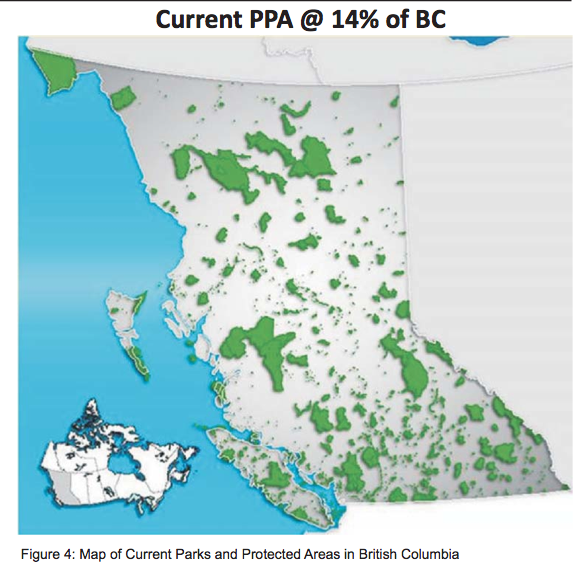 Outside of the PPAs system, forests are managed for a number of values on the same land base through the Forest and Range Practices Act (FRPA). FRPA is called results-based legislation, which means that the BC Government sets objectives in the Forest Planning and Practices Regulation. Industry then develops, in a Forest Stewardship Plan, “results and strategies” that they will commit to implementing on the ground to achieve government objectives. The government, through monitoring, can assess the performance of the industry “results and strategies” against provincial government objectives, and can seek changes when results are failing to meet objectives.
Outside of the PPAs system, forests are managed for a number of values on the same land base through the Forest and Range Practices Act (FRPA). FRPA is called results-based legislation, which means that the BC Government sets objectives in the Forest Planning and Practices Regulation. Industry then develops, in a Forest Stewardship Plan, “results and strategies” that they will commit to implementing on the ground to achieve government objectives. The government, through monitoring, can assess the performance of the industry “results and strategies” against provincial government objectives, and can seek changes when results are failing to meet objectives.
For example, the objectives for biodiversity and wildlife in the Forest Planning and Practices Regulation state: “The objective set by government for wildlife and biodiversity at the landscape level is, without unduly reducing the supply of timber from British Columbia’s forests and to the extent practicable, to design areas on which timber harvesting is to be carried out that resemble, both spatially and temporally, the patterns of natural disturbance that occur within the landscape.”
The Forest Stewardship Plans’ “results and strategies” are completed by forest tenure holders and then the government evaluates, over time, whether the measures carried out by the Forest Stewardship Plans are effective in meeting the government’s objectives. This evaluation is done by the Forest and Range Evaluation Program (FREP) within the BC Government. The onus is on government to prove measures are effective or ineffective.
The AG’s 2013 report: “An Audit of Biodiversity in B.C.: Assessing the Effectiveness of Key Tools” http://www.bcauditor.com/pubs/2013/report10/audit-biodiversity-bc-assessing-effectiveness-key-tools stated that: “We found that government doesn’t know if its actions are conserving biodiversity. There are several barriers to government being effective, including a lack of information, gaps in legislation and poorly implemented policies and tools.”
Changes in large complex ecosystems and assignment of causes and effects are difficult to measure. Challenges intensify with the passage of time, due to multiple stresses from multiple sources and natural variability in disturbances that shape ecosystems. Though difficult, a measure of the complexity and uncertainty needs to be periodically assessed and reported. Issues such as cumulative effects and fragmentation caused by roads, off-road activities, etc. are not currently addressed, so the adverse effects remain unknown and incremental effects are not currently factored into development decisions. A report entitled “Natural Resource Monitoring in British Columbia: A Compilation of Provincial Government Initiatives” provides an update of existing government monitoring initiatives that could help strategic periodic assessments.
After a decade of monitoring and reporting on the effectiveness of the current “results-based forest practices code” and sustaining the 11 forest values and public objectives, government has still not begun to assess the effectiveness of landscape-level set aside areas for Old Growth Management or for other landscape-level conservation measures such as Ungulate Winter Ranges. The 2013 ADM’s report on progress for landscape level biodiversity states: “Landscape-level indicators under development and pilot testing.” http://www.for.gov.bc.ca/ftp/hfp/external/!publish/frep/reports/FREP_ADM%20Stewardship%20Report_July2012.pdf . After a decade of results-based regulation, the public does not know. Neither apparently, does the BC Government.
Some of the conservation tools already developed have never been applied to forest practices and planning, such as the need to preserve Wildlife Habitat Features, which are stand level features such as dens, mineral licks, trails, etc. The government web site states: “No wildlife habitat features have been identified to date. Work to legally establish wildlife habitat features is ongoing.” http://www.env.gov.bc.ca/wld/frpa/habitatfeatures.html
A conservation tool to define connectivity corridors was developed as Forest Ecosystem Networks that explicitly show on maps, areas where there would be objectives for higher stand structure retention. (See “Designing Forest Ecosystem Networks – Biodiversity Guide Book” http://www.for.gov.bc.ca/tasb/legsregs/fpc/fpcguide/biodiv/chap3.htm ). Landscape level plans and mapping of these networks were not enabled in the 1990s due to a six percent timber impact restriction for all conservation measures linked to forest practices legislation. Whether this timber supply impact cap has been sufficient to sustain values has never been adequately assessed. The need to connect natural areas has increased in light of climate change as has the need to know how to design tenured development to mitigate against the adverse effects of ecosystem fragmentation.
Strategic Land Use Planning: Then and The Need for This Again
The doubling of the percent of PPAs in the 1990s and early 2000s provided a forum for discussion of where to place new protected areas. Strategic land use plans were completed for most areas of B.C. through a facilitated round table process that included stakeholder involvement, but lacked participation by First Nations.
Many things have changed in the two decades since some of these plans were completed, such as increases in insects, fire and disease disturbances linked to changes in climate. There is a need to build on and continue with this strategic level of land use planning, with local involvement to test the land use plan objectives and the biological resilience of landscapes in light of accelerated development and climate shifts. This means assessing the landscape connectivity, including connectivity of PPAs, the effectiveness of conservation measures among PPAs, and filling gaps. FER asserts that a sub-regional scale similar to the Land and Resource Management Plan (LRMP) is needed. FER supports devolving to a local level as the best path toward an optimal, sustainable outcome for natural resource values. Greater local involvement is central to a successful stewardship model as those at the sub-regional level understand the local landscape and have the most to gain or lose with regard to sustainable management of the largest number of resource values.
There is evidence from conservation science that there are thresholds of fragmentation of natural ecosystems. There are thresholds in size of protected areas and distance between protected areas. When these thresholds are crossed, and protected areas are too small or too isolated, then there is loss of ecological integrity within PPAs. Also, as the distance from other PPAs increases, there is loss of integrity across the larger ecosystem. Thresholds of size and distance among areas exist at different points for different species, but there is evidence that between 30 and 50 percent of the natural ecosystem is necessary to support the viability of most species. When viewed on their own, the current PPAs shown on the map in Figure 4, are too isolated, and in many areas, too fragmented to sustain the species. Within the broad ecosystem context, these PPAs have lost their integrity. This is not true of the largest PPAs. Integrity of the whole system needs to be improved with a strategic plan that consciously addresses connectivity among PPAs.
Other much poorer countries such as Costa Rica have set aside 30% of their land base for conservation purposes (more than double that of B.C.). See Forum Keynote speaker Stephen Woodley for an international overview. http://www.unbc.ca/sites/default/files/sections/bc-protected-area-research-forum/woodley-emergingrolesforprotectedareas-bcparm.pdf
Connectivity
 The map in Figure 4 was obtained from the internet and shows that 14% of B.C.’s land base has been set aside for PPAs. This map is not current, as 15% is currently protected, but its purpose is to show the distribution, size and connectivity of the current PPAs system. Six percent of the most ecologically productive valley bottoms are on private lands leaving 79% outside of protected areas and therefore available for development. The more productive forested lands are in the timber harvesting land base (THLB).
The map in Figure 4 was obtained from the internet and shows that 14% of B.C.’s land base has been set aside for PPAs. This map is not current, as 15% is currently protected, but its purpose is to show the distribution, size and connectivity of the current PPAs system. Six percent of the most ecologically productive valley bottoms are on private lands leaving 79% outside of protected areas and therefore available for development. The more productive forested lands are in the timber harvesting land base (THLB).
There are elements of connectivity in the THLB, including Riparian Reserves, Wildlife Tree Reserves, Old Growth Management Areas and Wildlife Habitat Areas, that are designated for conservation. However these designations offer a lower level of legal protection than Provincial Park status. Nevertheless, the end result is that we are fragmenting B.C. without a strategic look at landscape use by species, and where there needs to be improved landscape habitat protection to maintain long-term landscape connectivity.
The history of human expansion and habitat fragmentation indicates there is a point when the originally intact ecosystems become separated and isolated so that the species and functions in those fragments diminish, species and ecosystems services decline, and species cease to exist there.
 The maps in Figure 5 show how the diversity of carnivore and ungulate species has declined and species ranges have shrunk over the last 400 years. This example also shows that B.C. has one of the last relatively intact carnivore/ungulate predator/prey systems remaining in North America south of the 60th parallel. See
The maps in Figure 5 show how the diversity of carnivore and ungulate species has declined and species ranges have shrunk over the last 400 years. This example also shows that B.C. has one of the last relatively intact carnivore/ungulate predator/prey systems remaining in North America south of the 60th parallel. See
http://scholarsarchive.library.oregonstate.edu/xmlui/bitstream/handle/1957/22137/RippleWilliam.FERM.RangeContractionsNorthAmerica.pdf?sequence=1 to read the full report by Lailbert and Ripple.
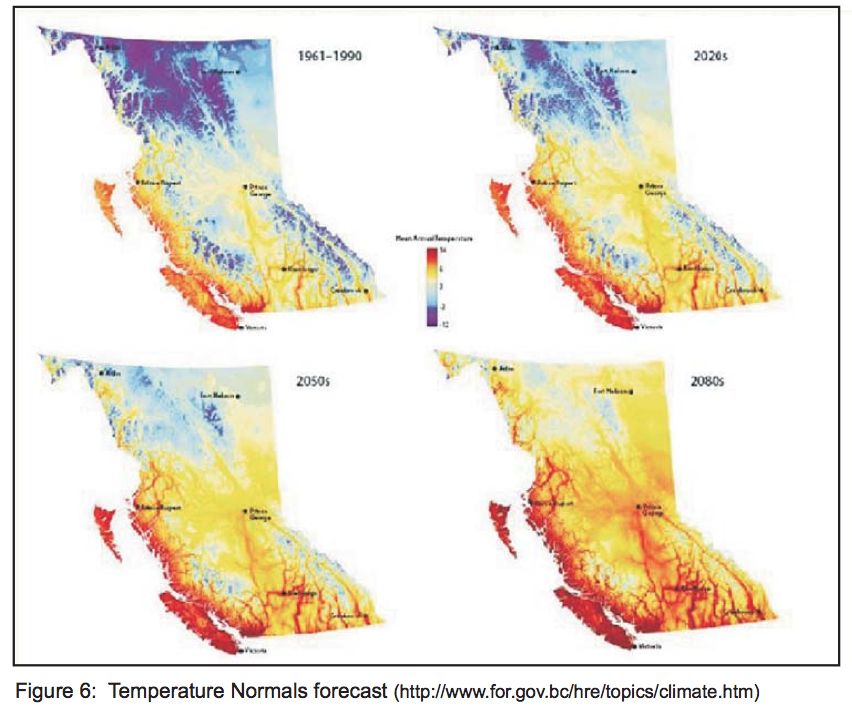 The time series maps in Figure 6 from Hamann and Wang 2006 are based on climate data from 1960 to 1990 with a forecast to 2020, 2050 and 2080. (Read the article at http://www.ualberta.ca/~ahamann/publications/pdfs/Hamann_Wang_2006.pdf ). The overall warming shows huge shifts and the uncertainty and risk to existing ecosystems and species for movement and persistence in this warmer world. Without some conscious strategic look at options, it most likely means that many of the species we take for granted will not be able to make the shifts they need using the current conservation system.
The time series maps in Figure 6 from Hamann and Wang 2006 are based on climate data from 1960 to 1990 with a forecast to 2020, 2050 and 2080. (Read the article at http://www.ualberta.ca/~ahamann/publications/pdfs/Hamann_Wang_2006.pdf ). The overall warming shows huge shifts and the uncertainty and risk to existing ecosystems and species for movement and persistence in this warmer world. Without some conscious strategic look at options, it most likely means that many of the species we take for granted will not be able to make the shifts they need using the current conservation system.
The most practical way to help conserve biodiversity is through better landscape connectivity and increases in natural or near natural areas. Others have noted the need for conscious landscape level conservation in light of climate change. See Jim Pojar’s 2010 report “A New Climate for Conservation: Nature Carbon and Climate Change in B.C.” http://www.davidsuzuki.org/publications/downloads/2010/NewClimate_report_DSF.pdf
Renewable Resource Management: Status Quo
The next part of this presentation relied on information compiled by Archibald, Ellis, Eastman and Nyberg 2012 in an article entitled “Trends in Renewable Resource Management.” Only two graphs are used to show the declining support for renewable resource management in B.C. This paper can be found on the web at http://bcforestconservation.com/wp-content/uploads/TrendsinRR.pdf.
FER agrees with their conclusion: “that decreases in funding and professional staffing are jeopardizing key functions both inside and outside of government, and are putting the province’s renewable natural resources at increasing risk.”
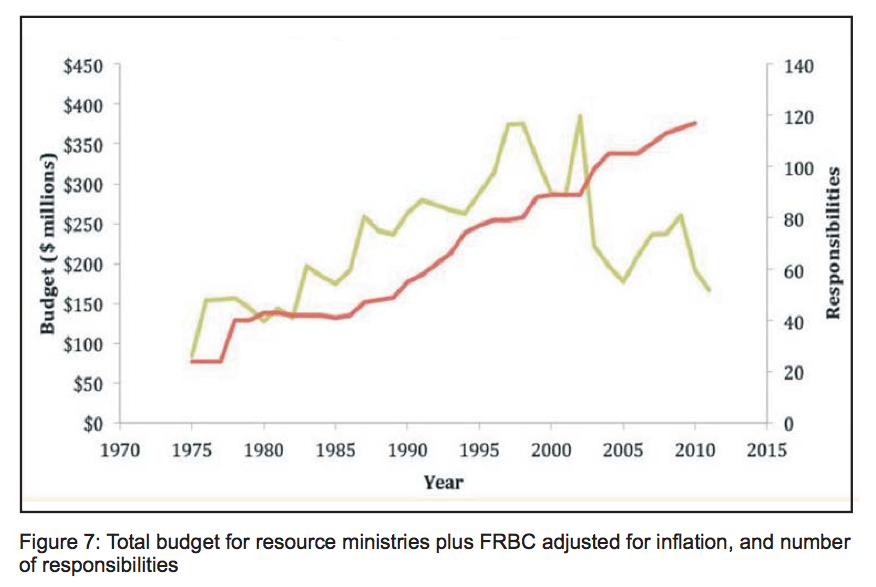 The graph in Figure 7 shows the work load increase (red line) for government staff and the budget decline (green line) that began most sharply in early 2002 and currently matches 1982 levels of funding. The graph shows less resource staff in Parks, Environment and Forests and Lands and smaller budgets to do more complex sustainable resource management and increased legislated requirements. The reports of the AG already cited, provided some of the specifics on where the BC Government is failing.
The graph in Figure 7 shows the work load increase (red line) for government staff and the budget decline (green line) that began most sharply in early 2002 and currently matches 1982 levels of funding. The graph shows less resource staff in Parks, Environment and Forests and Lands and smaller budgets to do more complex sustainable resource management and increased legislated requirements. The reports of the AG already cited, provided some of the specifics on where the BC Government is failing.
 The graph in Figure 8 shows how the total budget of the BC Government has doubled since 1975, while the budget for the resource ministries has remained at the same level since 1975. The increases in government budget have not been allocated to natural resource ministries. Since 1998, more has gone to H (Health), E (Education) and SS (Social Services).
The graph in Figure 8 shows how the total budget of the BC Government has doubled since 1975, while the budget for the resource ministries has remained at the same level since 1975. The increases in government budget have not been allocated to natural resource ministries. Since 1998, more has gone to H (Health), E (Education) and SS (Social Services).
One example of the implications of declining staff and budget can be demonstrated by looking at a government study that identified at least 134,000 stream crossings in the province that present potential barriers to fish passage. Using the Forest Practices Board’s review, 58% of crossings in fish-bearing habitat posed moderate to high risks of blocking fish passage, which implies that at least 77,000 crossings require restoration. The current funding levels provided allow restoration of only 25 crossings per year. At this rate of funding, it would take 3,000 years to restore damaged or unmaintained stream crossings.
Current BC Government Direction
Current overall BC Government direction lacks balance. It shows a strong economic emphasis with little or no mention of sustaining complex environmental values. From the most recent Throne Speech…2013: “Your government will work to seize the economic opportunity of a lifetime presented to all of us by our surplus natural gas. It will protect the economy by controlling spending and balancing the budget. Your new government will act on the mandate you have given it, to keep BC’s economy strong so we can secure tomorrow, together.” In a mandate letter to the Minister of the Environment, there is some recognition of environmental values and a need to integrate these with development, specifically a new protected area in the Sacred Headwaters of the Skeena and a high level forum on conservation with ENGO and FNs. See entire mandate letter at http://www.gov.bc.ca/premier/cabinet_ministers/mary_polak_mandate_letter.pdf
Some Solutions
FER suggests that greater local involvement and increased community based collaboration and authority will provide governance capable of sustaining multiple resource values and maintain the underpinning of productive, diverse and resilient biological systems on which we depend for our future diverse economic base. FER is not alone in seeking a new vision with increased local involvement (see reports from Healthy Forest and Healthy Communities http://bcforestconversation.com/wp-content/uploads/EXECUTIVE-SUMMARY.pdf ).
There are some First Nations co-management examples in B.C. that provide an alternative to the FN legal challenges to government and resource showdowns. It is believed that cooperation and collaboration will provide greater certainty in the short and long term over land use, opportunities for development and conservation. It is time to move beyond the stakeholder-to-government model and the First Nations-to-government model, to “everyone in on the same land base at a planning scale that provides greater operational certainty for all.”
Anna Rozwadowska in her Master’s Thesis (2010), identified a link between climate change, protected areas, and Community-Based Natural Resource Management (CBNRM). She noted that capacity development for local level resource management and conservation is essential for adapting to the effects of climate change on ecosystems and natural resources at the global level. She pointed out that protected areas and ecosystems offer natural buffers against the effects of extreme weather events for many communities, and provide ecosystem services, such as micro-climate stabilization and carbon sequestration through intact vegetation, that are increasingly important in a time of rapid environmental change. Therefore, conservation of these resources will become more important to resource-based communities.
Sustainable resource management at the community level will also help communities build their capacity to adapt to the effects of climate change on the natural resources on which local livelihoods depend. The United Nations Framework Convention on Climate Change also recognizes CBNRM as a climate change adaptation strategy. As such, there is tremendous potential for CBNRM, affiliated with protected areas, to help resource-based communities adapt to the effects of climate change.
As part of this new strategic direction, FER asserts that ERs and conservancies could contribute more. This would necessitate augmenting their roles and require political will and local stewardship that would allow for increased use of these long term conservation tools. This would mean adjusting BC Government protected areas policies, systems planning, land acquisition and operations to:
1. Use Ecological Reserves to identify, establish and protect climate change refugia.
Dr. Constance Millar (2010) of the US Forest Service recommends protecting areas that meet specific criteria as a climate change refugium (e.g. Devil’s Posthole National Monument). She asserts that this is a crucial climate change adaptation strategy for not only the health of biodiversity but also for the health of future natural resource economies.
2. Use Conservancies to assist communities build their capacity to adapt to the effects of climate change on the natural resources on which local livelihoods depend. Enhanced use of these tools would contribute to landscape connectivity.
FER’s final message is one of hope and awe. There is an amazing video about an African buffalo calf attacked by a pride of lions and two crocodiles. The video is 100% real and was filmed back in 2010 by Jason Schlosberg in South Africa’s Kruger National Park while he was on safari. Seventy-three million people viewed it on YouTube. At one point in the video, all are convinced that there is no hope for the buffalo calf. If you haven’t seen it, check the unexpected end of this event, which depends on the mobilization of the entire herd of buffalo to save the calf. Like this example of the African Buffalo, our future success as a species will depend on our ability to analyze and communicate the threats, and to collaborate to respond to those threats and remove obstacles, thus enabling the vulnerable to mobilize what resources they have left, take advantage of opportunities, and persist.
Authors’ Biographies
Mike Fenger is President of Friends of Ecological Reserves, a small NGO supporting Parks staff with their management of ERs. Mike is also on the Board of Directors of the BC Chapter of CPAWS (Canadian Parks and Wilderness Society) and a Forester who has worked in conservation of biodiversity when working for Ministry of Environment. When not volunteering, Mike manages his consulting company Mike Fenger and Associates Ltd. http://www.mikefengerandassociates.com/ . Before private practice he worked for BC Environment as a forester and biodiversity specialists. Mike is the lead author of the Lone Pine Field Guide Wildlife and Trees in BC.
Jenny Feick, besides being on the Board of FER, is the longest serving Board member of the Columbia Mountains Institute of Applied Ecology (http://www.cmiae.org/ ). She is a biologist with a Masters in environmental science and a PhD in natural resource geography. Jenny recently initiated Nature Wise Consulting, which offers services in environmental research, communications and leadership (http://naturewise.me/consulting/ ). She worked as a manager for the BC Ministry of Environment for 12 years and for Parks Canada for over 20 years. When not volunteering or doing environmental consulting, Jenny teaches nature inspired, alignment conscious hatha yoga (http://naturewise.me/yoga/) in various community centres and parks in Victoria, B.C. or goes hiking, cross-country skiing, or kayaking with her husband Ian Hatter.

